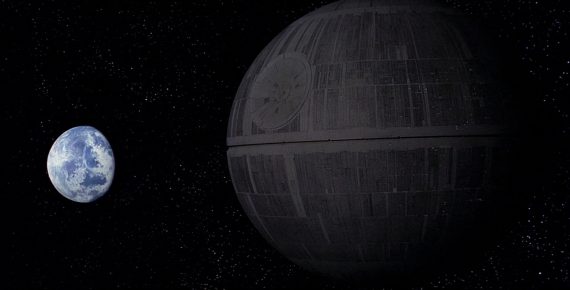Is The Death Star Cost Effective?
A group of students at Lehigh University have recently calculated that the construction cost of the Death Star was roughly 852 Quadrillion Dollars. While that sounds like a lot of money and, given the ultimate fate of the two iterations of the project it all seems like a total waste, Kevin Drum argues that the project would be surprisingly cost effective:
For starters, this number is too low. Using the same aircraft carrier metric they did, I figure that the price tag on the latest and greatest Ford-class supercarrier is about 100x the cost of the raw steel that goes into it. If the Death Star is similar, its final cost would be about 1.3 million times the world’s GDP.
But there’s more. First off, the technology of the Star Wars universe is well in our future. How far into our future? Well, Star Trek is about 300 years in our future, and the technology of Star Wars is obviously well beyond that. Let’s call it 500 years. What will the world’s GDP be in the year 2500? Answer: assuming a modest 2% real growth rate, it will be about 20,000 times higher than today. So we can figure that the average world in the Star Wars universe is about 20,000x richer than present-day Earth, which means the Death Star would cost about 65x the average world’s GDP.
However, the original Death Star took a couple of decades to build. So its annual budget is something on the order of 3x the average world’s GDP.
But how big is the Republic/Empire? There’s probably a canonical figure somewhere, but I don’t know where. So I’ll just pull a number out of my ass based on the apparent size of the Old Senate, and figure a bare minimum of 10,000 planets. That means the Death Star requires .03% of the GDP of each planet in the Republic/Empire annually. By comparison, this is the equivalent of about $5 billion per year in the current-day United States.
In other words, not only is the Death Star affordable, it’s not even a big deal.
Even if this is true, though, one has to wonder if the Galactic Empire really got its money’s worth. For one thing, there’s the lost tax revenue from the destruction of Alderaan. For another, there’s the fact that the project stands as the greatest failure in the history of military contracting.
If I was Palpatine, I’d demand a refund.







Even Galactic Emperors are slaves to the military-industrial complex.
Yes, death star as gigantic broken windows fallacy.
The Star Wars world is not of the future! The very first line of the very first film in 1977 began: “A long time ago in a galaxy far, far away…”
While the scale of the technology may be far into our future, technically speaking the technology is hundreds or thousands of years in our past.
“A
, in a galaxy far, far away…”
@John Peabody:
Damn John, beat me to it.
I assume you’re referring to the “official story” that the Death Stars were destroyed in longshot raids by a disorganized band of poorly trained and equipped rebels. Don’t fall for the Imperial Propaganda! The Emperor is lying to you: the destruction of the Death Stars were the result of an inside job.
@Neil Hudelson:
@John Peabody:
Fair point from both of you on that one, I think it would be more accurate for Drum to have said that SW technology was more advanced than our current level of technology regardless of what time it may have taken place.
Just have to note this Gizmodo article from 2009, which seems far more realistic and includes some of the operating costs. Looks like the only way to resolve this is to build a Death Star…who’s in?
There is one big flaw with the Death Star cost analysis: the assumption the Death Star is the same density as an aircraft carrier is unlikely to hold given the we know from Return of the Jedi that most of the interior of the Death star is a large central void. If you consider them to be large hollow balls, they use far less steel than they are predicting here.
@ptfe:
Hopefully not the Iranians, or we’ll never hear the end of it.
The Star Wars world is not of the future! The very first line of the very first film in 1977 began: “A long time ago in a galaxy far, far away…”
How do you know the line is addressed to people on earth in the 20th or 21st century? You could suppose it’s a story being told to audiences in the distant future.
In any case, Star Wars is unquestionably futuristic, and that’s the important point. Whether it represents our future, or some ancient civilization from another galaxy, or (most likely) an alternate universe with its own history, it is clearly meant to resemble the type of civilization we might one day become. Personally, I think Lucas just stuck that line in to preserve the fairy-tale feel and to emphasize that it’s not hard sci-fi. I wouldn’t read much further into the line than that.
The books The Science of Star Wars, by Jeanne Cavelos, and Physics of the Impossible, by Michio Kaku, speculate that Star Wars is a Type III civilization, while Star Trek is Type II. According to this scale, we aren’t yet even a Type I. The basic idea behind this scale is that Type I civilizations are those that have conquered the energy of a planet, Type II the energy of a star, and Type III the energy of a galaxy. For a more detailed explanation, go here:
http://en.wikipedia.org/wiki/Kardashev_scale
@Stormy Dragon:
A few points of rebuttal here.
1. The second death star was still under construction, so we really don’t know how filled in the end design was.
2. The second death star, according to all canon sources that I’ve read, was significant;y redesigned from the first one, so we don’t know what the interior structure of the first one really was.
3. Actually, if you remember the scene when Lando and Wedge attacked the second death star, they flew through 10s of miles of very narrow passageways before they reached the inner void where the reactor was. Most of the depth of the death star seemed pretty solid to me. That inner void was not as big as you think it is, probably just a few miles wide
@Ben:
To back up my point:
http://www.youtube.com/watch?v=kwz_fZPt6Ic
@Kylopod:
It’s also worth remembering that, at least in the Original Trilogy, Lucas was paying tribute to the Saturday morning serials of the 30s (i.e., Flash Gordon, etc) all of which had that kind of opening script crawl
@Kylopod:
I always assumed Star Wars was the dramatic interpretation of a sacred text Lucas keeps locked in his vault on his ranch. This text tells of what we once were, and what we will be again.
I thought that’s what everyone assumed…
@Ben:
Perhaps you can explain some of the timing then.
The original death star was already in the construction stages when Anakin became Darth Vader. By that time line it took another 16-20 years to complete it (I don’t know Luke and Leia’s age).
Yet the second death star was partially complete–and functional–shortly after the destruction of the first death star.
How significant of a redesign could they have had? Either they had to redesign in almost while the first death star was still in the planning stages, or the construction of the second death star was drastically accelerated.
And if its the former, why? The first death star was impervious except for one duct problem.
Neil,
Yea that part of the timing never made sense to me. If the original Death Star was under construction by the end of ROTS then why did the rebels wait for nearly two decades to try to destroy it, for one thing?
Well, at this point, I must pull this video regarding government contractor building the second death star from Clerks. http://www.youtube.com/watch?v=iQdDRrcAOjA
@Ben:
1. The fact they had to fly through all those tunnels to get to it suggests that the central void part at least WAS finished. You can also see that there appears to be no unfished construction in the center of the death star vs. the surface which has visibly missing parts and scaffolding all over the place. This makes sense since the central void houses the main reactor core: since the main weapons are working, the reactor would have to have been completed too in order to power them.
2. If you watch the video you post, they make a hard right turn at :30, then at :50 they reach a split where part of the team makes another hard right (“see if you can get some of those tie fighters to follow you back to the surface”) and the rest makes a hard left to get into the central void. That suggest most of the tunnel run was actually parallel to the surface of the deathstar, with two shorter vertical segments to get inot the horizontal tunnel and then from the tunnel into the reactor.
3. If you compare the speed the background is passing the ships on as they approach the surface of the death star (:00) vs. when they’re in the reactor (1:14), you’ll notice the reactor is much slower. This suggests the central void is a lot bigger than it appears due to the forced perspective.
@Doug Mataconis: It’s usually a good idea to just pretend the prequel films were never made.
Doing that makes my life a lot happier. 🙂
Timothy,
This is true.
@Stormy Dragon:
The horizontal tunnell also explains why it took the Millenium Falcon a full minute to get into the reactor core but only 20 seconds to get back out. On the way out they came up the left side of that T-split and then left directly through the right side, skipping the hotizontal tunnel completely.
Tax or tax not, there is not try
@rodney dill:
Pretty sure Palpatine wouldn’t have any moral objections to deficit spending.
Let’s say the universe is 15 billion years old or so. The star wars galaxy could have evolved 12 billion years ago, with the civilizations starting 8 billion years ago. So they have 8 billion years of evolution ahead of us. So you can see why they are ahead of us technologically.
@rodney dill:
@Doug Mataconis:
The Empire probably didn’t have as big of a worry of deficit spending as we do. Storm Troopers and Darths make really efficient tax collectors.
Ok, this discussion is way too geeky for me.
This is the best debate on OTB so far.
@Neil Hudelson:
You have a point there.
@Neil Hudelson:
@Doug Mataconis:
It get’s even weirder when you learn that the second Death Star was nearly six times bigger than the first one.
All the Lehigh figures have done s determine the rice of really big pile of steel. Someone steel needs to actually transform that big pile in a functional battlestation. I tried to determine the labor costs to do that — using 2012 dollars and 2012 technology — and just the labor costs alone dwarf the above estimate.